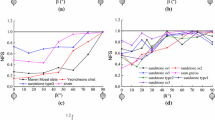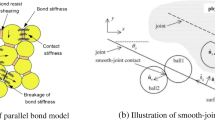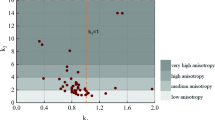Abstract
The evaluation of the mechanical properties of a transversely isotropic rock mass is a challenging task in practical engineering. This paper aims to study the relationships between the integrity parameters and mechanical properties of a transversely isotropic rock mass. The rock mass quality designation (RQD) is an important index and reference for rock mass quality evaluation that was introduced to establish the numerical models of a jointed rock mass with different integrities. The numerical models of a transversely isotropic rock mass were established using the bonded particle model (BPM) and smooth joint model (SJM) embedded into the Particle Flow Code software (PFC2D). After calibrating the microscopic parameters of the intact rock and structural planes, a series of compression tests of a transversely isotropic rock mass was carried out to determine compressive strength and deformation modulus, and main factors were considered including the RQD, inclined angle of structural planes, structural plane thickness, structural plane properties, intact rock properties, and confining pressure. The experimental results showed that the mechanical parameters and failure modes of a transversely isotropic rock mass were controlled by the integrity parameters. By comparing the value of σcm/σc (ratio of the compressive strength of rock mass to rock mass) and Em/Er (ratio of the deformation modulus of rock mass to rock mass) with field test results, the results obtained from the discrete element method were demonstrated to be reasonable.


















Similar content being viewed by others
References
Allegre CJ, Le Mouel JL, Provost A (1982) Scaling rules in rock fracture and possible implications for earthquake prediction. Nature 297(6):47–49
Amadei B, Savage WZ (1993) Effect of joints on rock mass strength and deformability. In: Comprehensive Rock Engineering: principles, practice and projects: 331-365
Amadei B, Savage WZ (1993) Effect of joints on rock mass strength and deformability. Comprehensive rock engineering: principles, practice and projects: 331–365
American Association of State Highway and Transportation Officials (AASHTO) (1996) Standard specifications for highway bridges, sixteenth edn. AASHTO, Washington DC
Aydan Ö, Dalgic S (1998) Prediction of deformation behavior of 3-lanes Bolu tunnels through squeezing rocks of North Anatolian fault zone (NAFZ). In: Proceedings of Regional Symposium on Sedimentary Rock Engineering. Taipei, China: 228-233
Aydan Ö, Ulusay R, Tokashiki N (2014) A new rock mass quality rating system: rock mass quality rating (RMQR) and its application to the estimation of geomechanical characteristics of rock masses. Rock Mech Rock Eng 47:1255–1276
Bahaaddini M, Hagan PC, Mitra R, Hebblewhite BK (2014) Scale effect on the shear behaviour of rock joints based on a numerical study. Eng Geol 181:212–223
Barton N (2002) Some new Q-value correlations to assist in site characterization and tunnel design. Int J Rock Mech Min Sci 39(2):185–216
Barton N, Loset F, Lien R, Lunde J (1980) Application of Q-system in design decisions concerning dimensions and appropriate support for underground installations. In: Bergman M, ed. Subsurface Space: Environmental Protection, Low Cost Storage, Energy Savings. In: Proceedings of the International Symposium. Pergamon Press, pp: 553-561
Bhasin R, Grimstaad E (1996) The use of stress-strength relationship in the assessment of tunnel stability. Tunn Undergr Sp Tech 11(1):93–98
Bieniawski ZT (1978) Determining rock mass deformability: experience from case histories. Int J Rock Mech Min Sci 15(5):237–247
Cho N (2008) Discrete element modeling of rock pre-peak fracturing and dilation. University of Alberta(phd)
Cho N, Martin CD, Sego DC (2008) Development of a shear zone in brittle rock subjected to direct shear. Int J Rock Mech Min Sci 45:1335–1346
Coon RF, Merritt AH (1970) Predicting in situ modulus of deformation using rock quality indexes. In: Determination of the In-Situ Modulus of Deformation of Rock. ASTM International:154-173
Cui Y (2019) Effect of joint type on the shear behavior of synthetic rock. Bull Eng Geol Environ 78(5):3395–3412
Cundall PA, Strack ODL (1979) A discrete numerical model for granular assemblies. Gdotechnique 29(1):47–65
Dan DQ, Konietzky H (2014) Numerical simulations and interpretations of Brazilian tensile tests on transversely isotropic rocks. Int J Rock Mech Min Sci 71:53–63
Debecker B, Vervoort A (2013) Two-dimensional discrete element simulations of the fracture behaviour of slate. Int J Rock Mech Min Sci 61:161–170
Deere DU (1964) Technical description of rock cores for engineering purposes. Rock Mech Rock Eng 1(1):16–22
Edelbro C, Sjoberg J, Nordlund E (2006) A quantitative comparison of strength criteria for hard rock masses. Tunn Undergr Sp Tech 22:57–68
Fossum AF (1985) Effective elastic properties for a randomly jointed rock mass. Int J Rock Mech Min Sci Geomech Abst 22(6):467–470
Franklin JA, Dusseault MB (1989) Rock engineering. McGraw-Hill, New York
Goel RK (1994) Correlations for predicting support pressures and closures in tunnels (phd). Thesis Nagpur, India: Nagpur University
Gokceoglu C, Sonmez H, Kayabasi A (2003) Predicting the deformation moduli of rock masses. Int J Rock Mech Min Sci 40(5):701–710
Hashemi M, Moghaddas S, Ajalloeian R (2010) Application of rock mass characterization for determining the mechanical properties of rock mass: a comparative study. Rock Mech Rock Eng 43:305–320
He MC, Leal e Sousa R, Müller A, Vargas E, Ribeiro e Sousa L, Xin C (2015) Analysis of excessive deformations in tunnels for safety evaluation. Tunn Undergr Sp Tech 45:190–202
He MM, Li N, Zhang ZQ, Yao XC, Chen YS, Zhu CH (2019) An empirical method for determining the mechanical properties of transversely isotropic rocks using drilling energy. Int J Rock Mech Min Sci 116:64–74
Hoek E, Brown ET (1997) Practical estimates of rock mass strength. Int J Rock Mech Min Sci 34(8):1165–1186
Hoek E, Carranza-Torres CT, Corkum B (2002) Hoek-Brown failure criterion-2002 edition.In: Bawden HRW, Curran J and Telsenicki M, eds. In: Proceedings of the Fifth North American Rock Mechanics Society (NARMS-TAC 2002) Symposium. Toronto, Canada: Mining Innovation and Technology: 267-273
Hoek E, Marinos PG, Benissi M (1998) Applicability of the geological strength index (GSI) classification for weak and sheared rock masses-the case of the Athens schist formation. Bull Eng Geol Environ 57(2):151–160
Hoek E, Carranza-Torres CT, Corkum B (2002) Hoek-Brown failure criterion-2002 edition.In: Bawden HRW, Curran J and Telsenicki M, eds. Proceedings of the Fifth North American Rock Mechanics Society (NARMS-TAC 2002) Symposium. Toronto, Canada: Mining Innovation and Technology: 267-273
Hofmann H, Babadagli T, Yoon JS, Zang A, Zimmermann G (2015) A grain based modeling study of mineralogical factors affecting strength, elastic behavior and micro fracture development during compression tests in granites. Eng Fract Mech 147:261–275
Huang TH, Chang CS, Yang ZY (1995) Elastic moduli for fractured rock mass. Rock Mech Rock Eng 28(3):135–144
Itasca Consulting Group Inc. (2014) PFC2D manual, version 5.0 Minneapolis, Minnesota
Kalamaras GS, Bieniawski ZT (1993) A rock mass strength concept for coal seams. In: Peng SS, ed. 12th Conf. Ground Control in Mining. Morgantown: 274–283
Kim H, Cho JW, Song I, Min KB (2012) Anisotropy of elastic moduli, P-wave velocities, and thermal conductivities of Asan Gneiss, Boryeong Shale, and Yeoncheon Schist in Korea. Eng Geols 147–148(5):68–77
Koyama T, Jing L (2007) Effects of model scale and particle size on micro-mechanical properties and failure processes of rocks - a particle mechanics approach. Eng Anal Bound Elem 31(5):458–472
Kulhawy FH, Goodman RE (1987) Foundations in rock. In: Bell FG (ed) Ground engineer’s reference book, vol 55. Butterworths, London, pp 1–13
Li C (2001) A method for graphically presenting the deformation modulus of transversely isotropic rocks. Rock Mech Rock Eng 34(1):67–75
Lin ZN, Xun WY, Wang W, Wang HL, Wang RB, Ji H et al (2018) Determination of strength and deformation properties of columnar transversely isotropic rocks using physical model tests. KSCE J Civ Eng 22(9):3302–3311
Masahide O, Catherine O, Tom S (2017) Empirical assessment of the critical time increment in explicit particulate discrete element method. Comput Geotech 86:67–79
Mitri HS, Edrissi R, Henning J (1994) Finite element modeling of cable bolted stopes in hard rock ground mines. Presented at the SME Annual Meeting. Albuquerque, USA: 94–116
Nicholson GA, Bieniawski ZT (1990) A nonlinear deformation modulus based on rock mass classification. Int J Min Geol Eng 8(3):181–202
Park B, Min KB (2015) Bonded-particle discrete element modeling of mechanical behavior of transversely isotropic rock. Int J Rock Mech Min Sci 76:243–255
Potyondy DO (2015) The bonded-particle model as a tool for rock mechanics research and application: current trends and future directions. Geosyst Eng 18(1):1–28
Potyondy DO, Cundall PA (2004) A bonded-particle model for rock. Int J Rock Mech Min Sci 41(8):1329–1364
Priest SD, Hudson J (1976) Discontinuity spacing in rock. Int J Rock Mech Min Sci Geomech Abst 13(5):135–148
Renshaw CE, Park JC (1997) Effect of mechanical interactions on the scaling of fracture length and aperture. Nature 386(3):482–484
Sheorey PR (1997) Empirical rock failure criteria. Balkema, Rotterdam
Sheory PR (1997) Empirical rock failure criterion. Oxford IBH Publishing co and AA. Balkema, Rotterdam
Singh B (1993) Workshop on Norvegian method of tunneling. CSMRS, New Delhi
Singh B, Viladkar MN, Samadhiya NK, Mehrotra VK (1997) Rock mass strength parameters mobilized in tunnels. Tunn Undergr Sp Tech 12(1):47–54
Soga K, Alonso E, Yerro A, Kumar K, Bandara S (2016) Trends in large-deformation analysis of landslide mass movements with particular emphasis on the material point method. Géotechnique 66(3):248–273
Tan X, Konietzky H, Frühwirt T, Dan DQ (2015) Brazilian tests on transversely isotropic rocks: laboratory testing and numerical simulations. Rock Mech Rock Eng 48(4):1341–1351
Wang J, Gutierrez M (2010) Discrete element simulations of direct shear specimen scale effects. Géotechnique 60(5):395–409
Wang SY, Sloan SW, Tang CA, Zhu WC (2012) Numerical simulation of the failure mechanism of circular tunnels in transversely isotropic rock masses. Tunn Undergr Sp Tech 32:231–244
Xia L, Zeng Y (2018) Parametric study of smooth joint parameters on the mechanical behavior of transversely isotropic rocks and research on calibration method. Comput Geotech 98:1–7
Xiao WM, Deng RG, Zhong ZB, Fu XM, Wang CY (2014) Experimental study on the mechanical properties of simulated columnar transversely isotropic rocks. J Geophys Eng 12(1):80–89
Yong MT, Tsao PF (2000) Preparation and mechanical properties of artificial transversely isotropic rock. Int J Rock Mech Min Sci 37(6):1001–1012
Yong MT, Ming CK, Juang CH (2006) An experimental investigation of the failure mechanism of simulated transversely isotropic rocks. Int J Rock Mech Min Sci 43(8):1163–1181
Yudbir F, Lemanza W, Prinzel F (1983) An empirical failure criterion for rock masses. In: Proc. 5th Int. Cong. ISRM, Melbourne. Rotterdam: Balkema: 131-138
Zhang LY (2010) Estimating the strength of transversely isotropic rocks. Rock Mech Rock Eng 43(4):391–402
Zhang Z, Cui YF, Chan D, Taslagyan K (2018) DEM simulation of vibrational fluidization of granular material. Granul Matter 20(71)
Zheng J, Yang XJ, Lü Q, Zhao Y, Deng JH, Ding ZJ (2018) A new perspective for the directivity of rock quality designation (RQD) and an anisotropy index of jointing degree for rock masses. Eng Geol 240:81–94
Acknowledgments
This study was funded by the National Natural Science Foundation of China (11902249, 11572246, and 51179153) and Scientific Research Program of Shaanxi Provincial Education Department (17JS091 and 2019JQ395).
Author information
Authors and Affiliations
Corresponding author
Rights and permissions
About this article
Cite this article
Huan, Jy., He, Mm., Zhang, Zq. et al. Parametric study of integrity on the mechanical properties of transversely isotropic rock mass using DEM. Bull Eng Geol Environ 79, 2005–2020 (2020). https://doi.org/10.1007/s10064-019-01679-9
Received:
Accepted:
Published:
Issue Date:
DOI: https://doi.org/10.1007/s10064-019-01679-9




